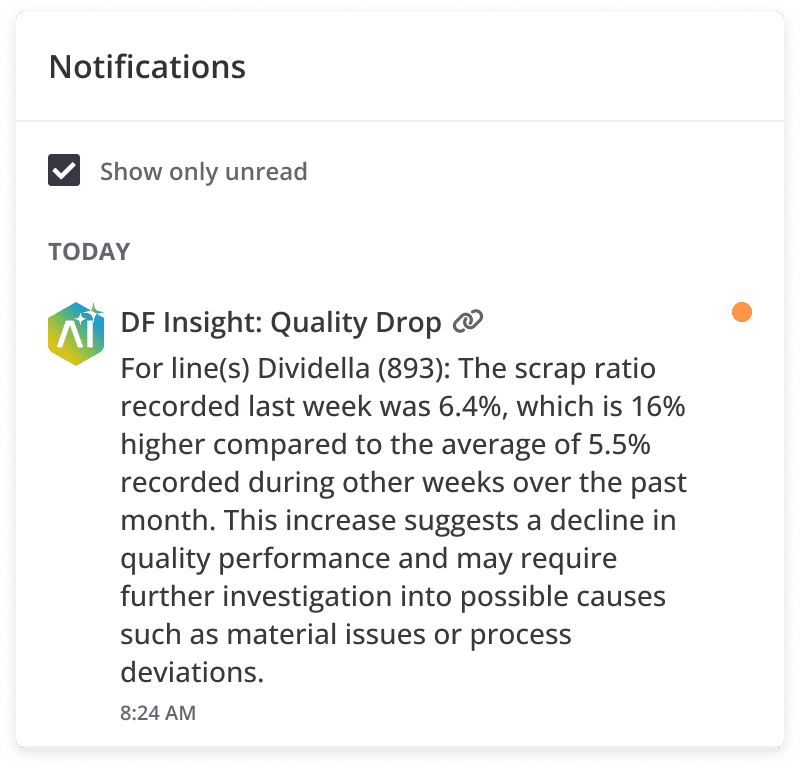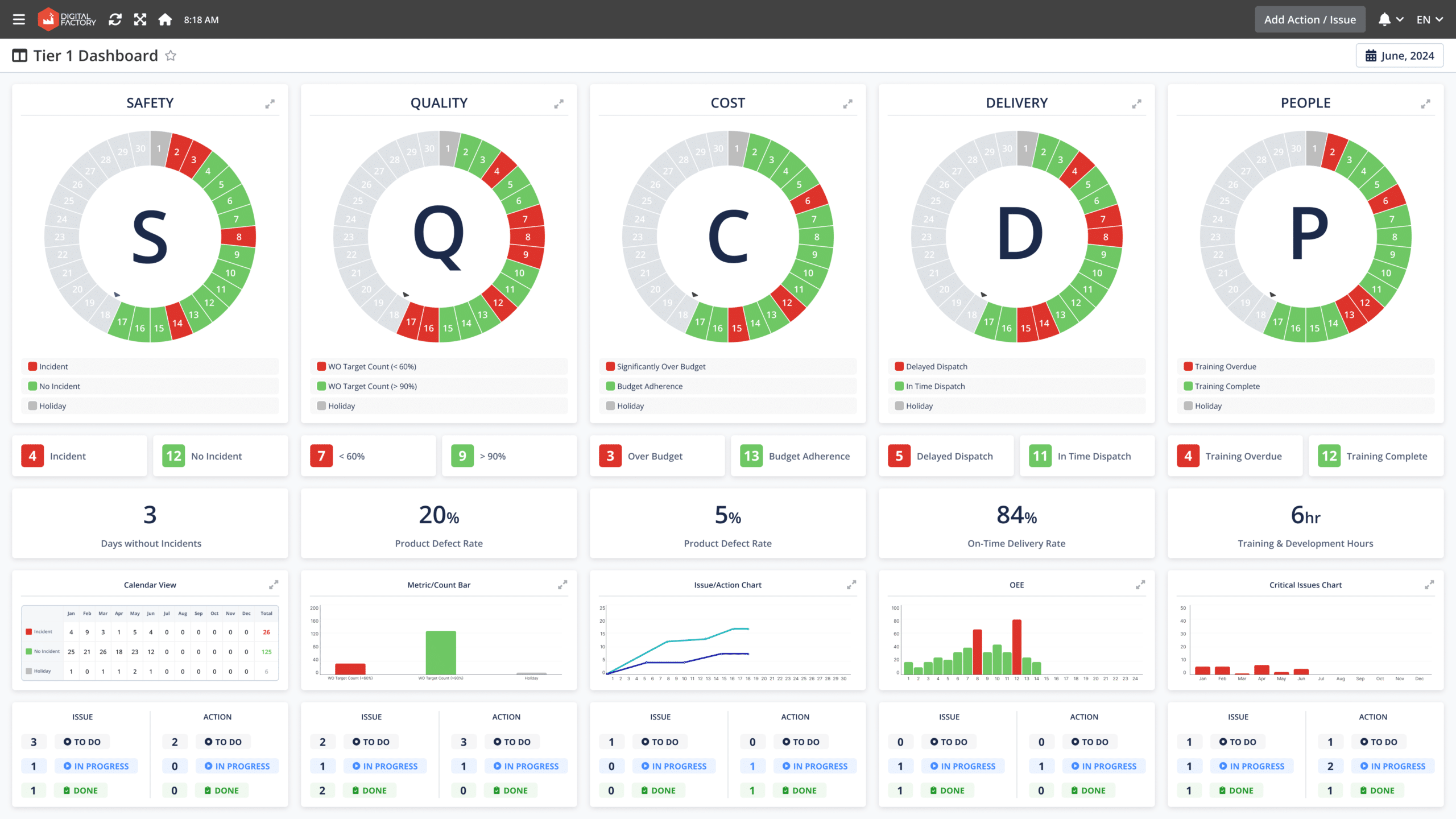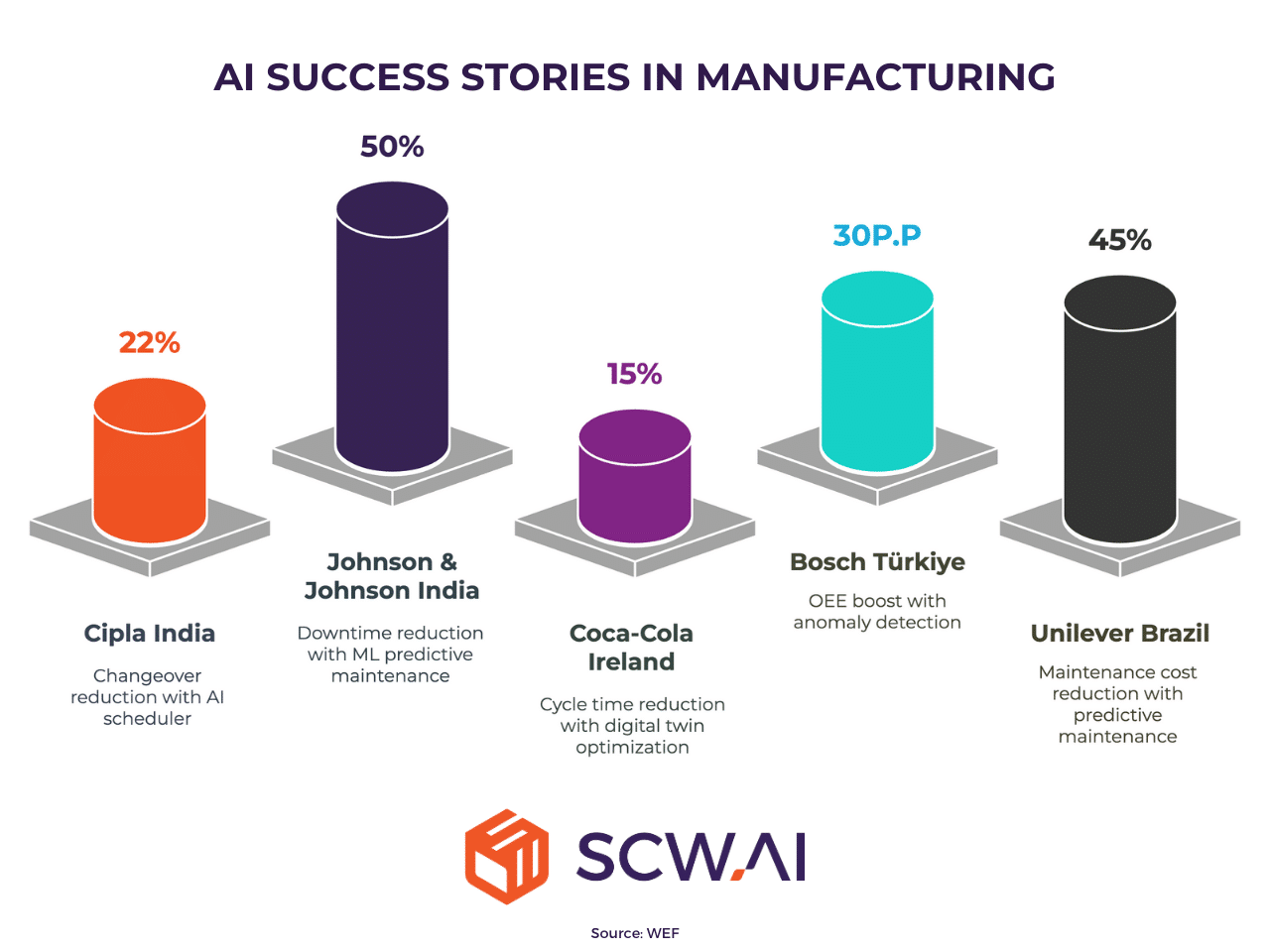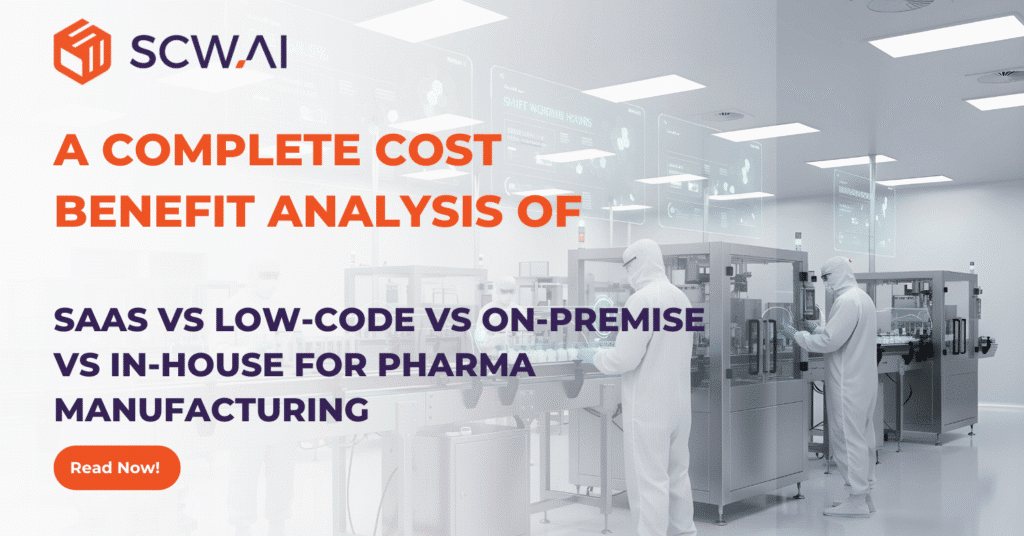The manufacturing industry is preparing to deploy AI for various applications. According to a 2025 Deloitte survey, manufacturers are on the path to AI adoption. While 23% are trying pilot projects, many others prioritize investments that pave the way for the digital infrastructure necessary for AI deployment, such as 40% for manufacturing analytics and 34% for automated data collection capabilities. The report also indicates that manufacturers are actively searching for AI use cases in manufacturing and want to strategize the most effective ways for their companies.
In an effort to enlighten manufacturing leaders about the practical applications of AI on the shop floor, we aim to spotlight seven distinct use cases of AI/ML models tailored specifically to the manufacturing industry. Then, we will introduce some lighthouse case studies that have achieved remarkable business outcomes by adopting AI in their processes. After introducing AI use cases and success stories in manufacturing, we will address frequently asked questions concerning AI in manufacturing and illustrate how SCW.AI supports manufacturers in harnessing AI to generate business value.

It is important to note that in this article, we intentionally exclude generative AI use cases for the manufacturing industry, for which we have prepared a complete article. We also exclude AI applications that can be useful for any industry, including logistics, business development, and customer relations; rather, we purely focus on shop floor use cases.
1. Optimize Scheduling for Different Business Needs
Thanks to AI capabilities, advanced planning and scheduling systems distribute work orders to production lines effectively based on the selected objective criterion such as:
- Cost minimization
- OTIF maximization
- Makespan minimization
- Just in time production (JIT) and more.
AI schedulers are a critical investment focus for manufacturers, as scheduling problems on the shop floor are categorized as NP (Nondeterministic Polynomial Time). This classification implies that finding the optimal solution is impossible due to the multitude of variables (lines, work orders, employees, etc.), constraints (work order interdependence, budget, limited resources, etc.), and conflicting objectives (cost minimization vs. due dates of work orders).
While achieving the absolute best solution is impossible, AI models with high computational power excel in finding optimal-like scheduling solutions for manufacturers within the given constraints and objectives. Thus, it can generate significant annual financial returns for large undertakings.
For various manufacturing industries, different application of AI-schedulers can be more profitable such as:
- Changeover Minimization for Pharma: In our OEE benchmarking analysis for pharmaceutical manufacturers, it was revealed that planned downtime constitutes a substantial 31% of staffed time. This figure is notably influenced by stringent quality compliance regulations like cGMP, with their impact reflected in extended changeover periods. For Pharma 4.0 companies, these downtimes can be reduced by 22% by strategically replacing major changeovers with minor changeovers through the implementation of AI schedulers.
- JIT Delivery for Food and Beverage: Food and beverages have a limited shelf life, requiring timely delivery and minimal inventory to enhance profitability. Algorithms and heuristics play a crucial role in minimizing production to meet customer demand and ensure the delivery of fresh products.
- Maximizing On-Time In Full (OTIF) for Consumer Goods: Companies in this industry may face significant financial penalties for late or incomplete deliveries, as they are frequently contractually obligated to meet strict On-Time In Full (OTIF) expectations, often with a target OTIF score. AI algorithms mitigate the risk of incurring OTIF penalties by strategically scheduling work orders based on their proximity to the due dates.
2. Reduce Unplanned Downtime with Predictive Maintenance
Algorithms can predict equipment breakdowns before they occur and notify workers to take preventive actions (see figure below). This enables manufacturers to optimize maintenance activities, minimizing unplanned downtime around 50% as in the case of Johnson and Johnson and reducing maintenance costs up to 10% per Deloitte.

The cost reduction achieved by AI/ML models in maintenance activities stems from two key dimensions. Firstly, these models automate the decision-making processes of the maintenance scheduling team, particularly in determining schedules for predictive/preventive maintenance activities. As a result, the scheduling team can save up to 50% of the time previously allocated for creating such schedules, allowing them to redirect their efforts toward other scheduling activities.
Secondly, in the absence of AI algorithms, the maintenance team is faced with a choice between reactive maintenance, initiated when the equipment stops working, and preventive maintenance based on the team’s experiential knowledge, which is often prone to errors. Within this dichotomy, overall equipment effectiveness (OEE) tends to remain low due to unplanned downtimes or unwarranted planned maintenance activities. Predictive maintenance seeks to strike a balance by leveraging historical shop floor data to minimize planned maintenance activities in the most effective manner.
To find out more information regarding predictive maintenance with AI/ML models, you can read our Predictive Maintenance with Machine Learning article.
3. Detect Anomalies to Optimize Productivity & Quality
By establishing a baseline of typical behavior, AI can swiftly identify anomalies, be it in production workflows, quality control procedures, or data handling processes. This real-time monitoring capability not only enhances overall security but also ensures the integrity and compliance of manufacturing operations.
For this AI use case in manufacturing, executives can leverage computer vision models to streamline data entry for manufacturing sites. These models interpret stack lights and issue notifications when lines are offline, reducing manual data entry efforts. Over time, these models can collaborate with predictive maintenance models to predict line status by analyzing patterns in green, blue, yellow, and red lights.
Moreover, the integration of diverse data sources, including information on equipment status, environmental heat, electricity currents, and machine vibrations, can significantly elevate production monitoring and predictive capabilities. This comprehensive approach not only enriches the overall data landscape but also enables more effective anomaly detection on the shop floor.
4. Get Personalized Shop Floor Information via AI Insights
Another innovative application of AI in factories is AI production insights, which can be an effective tool for operational excellence practices and the smooth and successful digital transformation of shop floors.
AI production insights provide tailored insides for each personnel according to their tasks, lines, work orders, and departments. These insights can be event-triggered issues requiring prompt action, as well as periodic highlights regarding manufacturing KPIs for which specific personnel are responsible to improve.
For instance, a maintenance worker can receive weekly insights regarding lines where the mean time to failure was worse compared to historical averages. A supervisor can receive information on line cleaning variance that was longer than expected for a certain line, or a quality control manager can observe the scrap rate for the lines they are responsible for. Thus, workers do not need to navigate through manufacturing analytics, where they encounter many metrics unrelated to their tasks and lines. Thanks to AI, the insights needed to achieve world-class manufacturing are readily available.



5. Improve Shop Floor Task Assignment with Al
Shop floors are dynamic and chaotic environments where hundreds of tasks are completed, and issues arise and are addressed through specific procedures. In this regard, each shop floor holds a potential knowledge base where actions taken for historical events are recorded.
Nowadays, solutions like Action Trackers leverage this knowledge base. For instance, digital SQCDP boards allow manufacturers to record historical responses to different incidents to resolve bottlenecks related to cost, safety, delivery, etc.

By combining such shop floor management tools with AI, automated task assignment capabilities for individuals and teams become possible. Algorithms analyze and categorize historical events, the solutions implemented, and their results on bottlenecks. This way, factories can automate managerial decision-making and address issues promptly.
6. Maximize FPY with Computer Vision Driven Quality Control Inspections
Computer Vision Driven Quality Control (CV-QC) is transforming inspection processes for manufacturers by leveraging advanced algorithms and artificial intelligence to analyze visual data from production lines, ensuring automated quality control inspections.
Traditional quality control methods, reliant on human inspectors, are time-consuming, subjective, and prone to errors. In contrast, CV-QC brings standardization to the process. Cameras and sensors capture real-time images of products, and sophisticated algorithms process this visual data to detect defects, deviations, or potential risks regarding workers’ working condition.
This way, manufacturers can identify quality issues in real time, access immediate information on scrap and units requiring rework, and take prompt actions to maximize first-pass yield—a crucial metric for maximizing compliance and customer satisfaction while minimizing costs.

It is crucial to highlight that this AI use case demands a substantial training period. Involving humans in the loop and employing supervised machine learning are often essential to train computer vision models to achieve high accuracy. These training models necessitate constant human feedback until models become proficient in the assigned task. The data labeling process, specifically image labeling, is paramount to teach computer vision models the meaning of visual data. Thus, implementation of computer vision models for quality training can be difficult for many manufacturers.
7. Run Realistic Simulations with Digital Twins
Digital twins, also known as AI simulations, serve as valuable tools for manufacturers, enhancing both their AI capabilities, especially in deep learning, and the skills of their workforce. To explain both use cases we will divide section into two pieces:
7.1 Augmented Workers with Digital Twins
Digital twins have the capability to visualize data, enabling executives to gain insights. As illustrated in the image below, for instance, a digital twin can highlight equipment pieces with high degradation using reddish colors, aiding workers in pinpointing the exact maintenance needs of the equipment.

Another use case of digital twins for manufacturers is training their employees through realistic simulations. Similar to flight simulation applications for training pilots, laborers can undergo training to operate equipment, and executives can explore new shop floor organizational methods without any real-world risks.
7.2 Augmented AI with Digital Twins
Deep learning models, exemplified by AlphaGo (an AI system which mastered the ancient game of Go), autonomously refine their performance through iterative training processes. AlphaGo’s mastery of the game through thousands of iterations showcases the capacity of these models to discover optimal strategies, enabling them to surpass human capabilities in specific tasks.
Digital replicas of factories offer a similar playground for deep learning models in manufacturing. For instance, a scheduler module can try numerous scheduling combinations in a digital twin and, like humans, learn by mistakes to make optimal decisions for its speciality.
Digital twins are also essential for master data optimization, a prerequisite for excellent schedule adherence. For instance, if your master data predicts a 30-minute changeover between two work orders, but past data from digital twins shows a 45-minute duration, the AI scheduler uses this empirical information to modify the scheduling. Manufacturers are able to create more effective and realistic schedules as a result.
To learn more about scheduling adherence you can read our In-Depth Guide to Schedule Adherence Report for Manufacturers article.
AI Case Studies in Manufacturing
In this section, we continue with leading AI case studies from the manufacturing industry. To provide a holistic view, we will use World Economic Forum-verified Lighthouse case studies from diverse industries and locations that adopt various AI use cases for shop floor optimization.

1. Cipla India Achieves 22% Changeover Reduction with AI Scheduler
Cipla India, a pharmaceutical manufacturer for oral solids, modernized its job shop scheduling capabilities using an AI model. This model aims to minimize changeover durations by replacing major cleanup and setup procedures with minor ones, without compromising other business objectives and in compliance with cGMP (current Good Manufacturing Practice). Thanks to this initiative, Cipla achieved a 22% reduction in changeover durations, a crucial improvement for pharmaceutical companies.
2. Johnson & Johnson India Reduces Unplanned Downtime by 50% with ML Predictive Maintenance
Johnson and Johnson India aimed to reduce production losses by deploying a machine learning model for predictive maintenance as part of their digital lean solutions. By analyzing historical machine performance data, the ML model successfully scheduled proactive maintenance while the machines were still operational. This initiative allowed them to reduce unplanned downtime by half.
If you operate in the pharmaceutical industry and are interested in the business potential, applications, case studies, future predictions, obstacles, and a clear roadmap regarding AI in pharma you can download our free white paper on it

3. Coca-Cola Ireland Lowers Cycle Time by 15% with Digital Twin-Driven Optimization
Coca-Cola’s Ireland factory deployed a digital twin model to identify optimal batch parameters for a fast and resilient production process. This was achieved by utilizing historical factory data and simulation capabilities, resulting in a 15% reduction in average cycle time.
4. Bosch Türkiye Boosts OEE by 30 Percentage Points with Anomaly Detection
Bosch Türkiye aimed to be a cost leader in its sector. To this end, they sought to improve Overall Equipment Effectiveness (OEE), which significantly correlates with cost due to its calculation as the ratio of productive time to scheduled time. As part of their OEE maximization strategy, they deployed an anomaly detection model. This model highlights potential and existing bottlenecks on the shop floor, allowing executives to take actions to minimize them. Consequently, Bosch increased its OEE by a significant 30 percentage points.
5. Unilever Brazil Cuts Maintenance Costs by 45% with Predictive Maintenance
The Unilever site in Indaiatuba, Brazil, one of the largest powder detergent factories globally, modernized its operations with cutting-edge technologies to protect its cost leadership, increase agility, and minimize Scope 1 Greenhouse Gas (GHG) emissions. One such solution was a predictive maintenance model that reduced the company’s maintenance costs by 45% and helped it reach its targets.
FAQs
What is AI in manufacturing?
An automation or augmentation tool that helps industrial facilities increase visibility, agility, and productivity. AI excels in addressing intricate challenges that surface regularly on shop floors, such as predictive maintenance and scheduling, due to its ability to handle substantial computational demands.
What AI-related expectations do we have for the manufacturing sector going forward?
As of now, the adoption of AI remains relatively low in the manufacturing industry. Overall, manufacturers are trailing in the integration of new technologies. However, we anticipate a widespread adoption of the technology, particularly in areas like predictive maintenance and scheduling, offering substantial potential for enhancing productivity and profitability.
How Long Does AI Deployment Take for Manufacturers?
This depends on the AI use case you prefer, your capabilities and whether you prefer in-house AI development or outsourcing.
Let us assume you want to deploy an ML model for predictive maintenance. Successfully deploying such a model first requires a robust dataset to identify meaningful correlations among events, including:
- Mean time to failure
- Mean time to repair
- Mean time between failures
- Production speed of machines
- Employee interactions with machines
- Heat and vibration of machine and breakdown and more.
To procure high-quality data for these purposes, the utilization of industrial IoT tools is essential. Additionally, proficiency in algorithm enrichment is paramount. In summary, if your digitalization level is low and lacks skilled IT/developers, the process of designing an AI model may span years, if not decades. In such circumstances, collaboration with a technology vendor becomes imperative to guarantee the attainment of high-quality data and the development of customized algorithms tailored to your shop floor requirements in a short period of time.
For your further questions regarding AI in manufacturing industry including its training, deployment and utilization in the shop floor you can contact us.
How Can Pharma Companies Utilize AI?
From manufacturing and supply chains to R&D, pharmacovigilance, and commercialization, AI is revolutionizing the pharmaceutical industry. On the other hand, particularly with pharmaceutical manufacturers, both our experience and industry reports suggest that the majority of factories lack sufficient infrastructure for building reliable and effective AI models. Pharma’s lag in collecting reliable and instant shop floor data, as well as insufficient capabilities for deriving insights by interpreting data, means that many medicine producers are not yet positioned to deploy AI in the short term.
How can SCW.AI Support Manufacturers in Implementing AI?
SCW.AI develops specialized algorithms for distinct AI applications in manufacturing. The company also ensures efficient data collection through IoT tools. Consequently, we provide effortlessly scalable cloud-based AI solutions tailored specifically for manufacturers, eliminating the requirement for extra hardware. Guaranteeing both cost-effectiveness and swift deployment, our offerings are designed to streamline processes and enhance operational efficiency.
We deploy AI models for manufacturers with following use cases:
- Production scheduling optimization
- AI production insights
- Anomaly detection
- Predictive maintenance
- Digital twins
To improve your profitability with AI, you can book a demo with us today!



